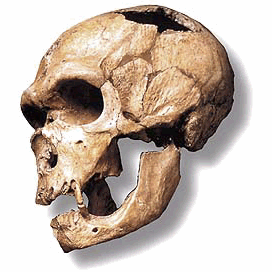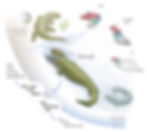Tiktaalik: It's All in the Wrist!
- Laurie L.
- Oct 20, 2020
- 3 min read
Updated: Jun 24, 2022
If you haven't heard yet, Tiktaalik is considered the "missing link" that was possibly the first of the vertebrates (animals with backbones) to go from water to land. Tiktaalik or Tiktaalik roseae is an extinct sarcopterygian genus, or lobe-finned fish, from the late Devonian period existing about 375 million years ago. It was discovered in 2004 by paleontologist Edward B. Daeshler when he saw that the skull was sticking out of a cliffside on Ellesmere Island in the Canadian Arctic Archipelago. What was the fossil Edward discovered? What were the features that gave us the poster boy that we now call "the missing link"?
Fish or Tetrapod?
Tiktaalik is technically a fish because it had gills and scales, but what makes it an important transitional organism between fish and tetrapods (fancy word for 4-legged land animal) is the wrist bones and the fact it could breathe oxygen from the air.
As you can see in the picture, fish have wrist bones in their fins, but they're weak and undeveloped. Animals with limbs have strong wrist bones to hold up their weight and allow them to move around.
You can compare this to your own wrist bones!
Tiktaalik is kind of an inbetweener when it comes to wrist bones. On one hand, it could swim with its fins, but on the other, it could also prop itself up, allowing it to go partially on land. It could use its' limbs for support like four-legged animals do! It survived in shallow freshwater and was able to occupy previously unoccupied niche space on the shore. It's the first fossil species that has been able to use the resources available on land.
Our Ancestry
There are many similar organisms to Tiktaalik during its time. Before Tiktaalik was discovered, paleontologists had studied many other extinct transitional organisms, such as Eusthenopteron and Acanthostega, which also provided clues about our ancestry.
We call Tiktaalik a transitional organism because it represents the in-between that connected the ancestry of water-living animals to land-living. It wasn't trying to evolve features for land-living, those features were simply mutations that were passed down because it helped Tiktaalik survive better due to Natural Selection. For more information on the processes of evolution and how that works, click this LINK. For more information on mutations, click this LINK.
Transitional forms help show the evolutionary steps leading from one lineage to another which is what we call Macroevolution. For more information on Macroevolution, click this LINK. We can compare the traits of organisms like this to similar ones to get an understanding of which traits evolved first in the newer lineages and how they functioned at the time. It's truly breath-taking to be able to look at a fossil from millions of years ago and see where it has led us in our world of diversity today!
__________________________________________________________________________________
Sources:
Ahlberg, P., Clack, J. (2006) A firm step from water to land. Nature 440, 748–749 (2006). https://doi.org/10.1038/440747a
Daeschler, E. B., Shubin, N. H., and Jenkins, F. A. (2006). A Devonian tetrapod-like fish and the evolution of the tetrapod body plan. Nature 440:757-763.
Niedzwiedski, G., Szrek, P., Narkiewicz, K., Narkiewicz, M, and Ahlberg, P. E. (2010). Tetrapod trackways from the early Middle Devonian period of Poland. Nature. 463: 43-48.
Shubin NH, Daeschler EB, Jenkins FA Jr. The pectoral fin of Tiktaalik roseae and the origin of the tetrapod limb. Nature. 2006 Apr 6;440(7085):764-71. doi: 10.1038/nature04637. PMID: 16598250.
University of Chicago. (2006, April 5). Newly found species fills evolutionary gap between fish and land animals. In News Office. Retrieved from https://www-news.uchicago.edu/releases/06/060405.tiktaalik.shtml
University of Chicago. (2009). The Search for Tiktaalik. In Tiktaalik roseae. Retrieved from https://tiktaalik.uchicago.edu/searching4Tik2.html
Keillor, Tyler. Paleontological Reconstructions, 6 Apr. 2006, www.tylerkeillor.com/tiktaalik/ua933bt3z8vwy38tc9ubcml8lqrb5r.
Museum Talk Archive. (2014, September 12). Sightings - Glanochthon. In Museum Talk Archive. Retrieved from https://museumtalkarchive.wordpress.com/2014/09/12/sightings-tiktaalik/
Wikipedia. Tiktaalik, Wikipedia, www.cs.mcgill.ca/~rwest/wikispeedia/wpcd/wp/t/Tiktaalik.htm.
"What Has The Head of a Crocodile and the Gills of a Fish?" Understanding Evolution, University of California, Berkeley, 2010, https://evolution.berkeley.edu/evolibrary/news/060501_tiktaalik#:~:text=Second%2C%20a%20whole%20series%20of,and%20Acanthostega%2C%20which%20also%20provided








